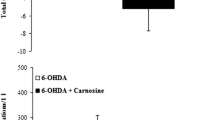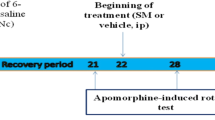Abstract
Purpose of the research
In this study, we appraised the effect of pre-treatment with intra-cerebro ventricular (i.c.v) microinjection of gastrodin (Gst) on catalepsy, motor imbalance, substantia nigra pars compacta (SNc) myeloperoxidase (MPO) activity, lipid peroxidation levels, nitric oxide (NO) production and total antioxidant capacity (TAC) in 6-hydroxydopamine (6-OHDA) rats model of PD.
Materials and methods
Male Wistar rats were pre-treated with i.c.v microinjections of Gst (20, 40 and 80 μg/3 μl/rat) for five consecutive days. Then, catalepsy and motor balance were induced by unilateral infusion of 6-OHDA (8 μg/2 μl/rat) into the SNc. The anti-cataleptic and motor balance improving effect of Gst was assessed by the Bar test and Rotarod 3 weeks after neurotoxin injection, respectively. SNc MPO activity and lipid peroxidation levels, NO production and TAC were assessed at the end of behavioral experiments.
Results
Our data demonstrated that Gst pre-treatment significantly (p < 0.001) was prevented motor in-coordination and catalepsy in neurotoxin lesioned rats. The most motor improving effect was seen at 80 μg Gst (p < 0.001). Pre-treatment of parkinsonian rats with Gst meaningfully (p < 0.001) was suppressed MPO activity, lipid peroxidation and NO production. Furthermore, the TAC level in the SNc was increased (p < 0.001) in Gst-microinjected rats about to the normal non-parkinsonian animals.
Major conclusions
In summary, pre-treatment with Gst abolished 6-OHDA-induced catalepsy and improved motor incoordination by decreasing: SNc MPO activity, lipid peroxidation levels and NO production, and restoring SNc levels of TAC to the levels of healthy rats.
Graphical abstract






Similar content being viewed by others
References
Benzie IF, Strain J (1999) [2] Ferric reducing/antioxidant power assay: direct measure of total antioxidant activity of biological fluids and modified version for simultaneous measurement of total antioxidant power and ascorbic acid concentration. Methods Enzymol 299:15–27
Blesa J, Trigo-Damas I, Quiroga-Varela A, Jackson-Lewis VR (2015) Oxidative stress and Parkinson’s disease. Front Neuroanat 9:91
Block M, Hong J (2007) Chronic microglial activation and progressive dopaminergic neurotoxicity. Biochem Soc Trans 35:1127–1132
Blum D, Torch S, Lambeng N, Nissou M-F, Benabid A-L, Sadoul R, Verna J-M (2001) Molecular pathways involved in the neurotoxicity of 6-OHDA, dopamine and MPTP: contribution to the apoptotic theory in Parkinson’s disease. Prog Neurobiol 65:135–172
Choi DK et al (2005) Ablation of the inflammatory enzyme myeloperoxidase mitigates features of Parkinson’s disease in mice. J Neurosci 25:6594–6600
Cohen G (1994) Free radicals, oxidative stress and neurodegeneration. In: Calne DB (ed) Neurodegenerative diseases. W. B Saunders, Philadelphia, pp 139–161
Cohen G (2000) Oxidative stress, mitochondrial respiration, and Parkinson’s disease. Ann N Y Acad Sci 899:112–120
Dai J-N et al (2011) Gastrodin inhibits expression of inducible NO synthase, cyclooxygenase-2 and proinflammatory cytokines in cultured LPS-stimulated microglia via MAPK pathways. PLoS ONE 6:e21891
de Lau LM, Breteler M (2006) Epidemiology of Parkinson’s disease. Lancet Neurol 5:525–535
Dexter DT, Jenner P (2013) Parkinson disease: from pathology to molecular disease mechanisms. Free Radic Biol Med 62:132–144. https://doi.org/10.1016/j.freeradbiomed.2013.01.018
Doo A-R et al (2014) Gastrodia elata Blume alleviates L-DOPA-induced dyskinesia by normalizing FosB and ERK activation in a 6-OHDA-lesioned Parkinson’s disease mouse model. BMC Complement Altern Med 14:107
Green PS, Mendez AJ, Jacob JS, Crowley JR, Growdon W, Hyman BT, Heinecke JW (2004) Neuronal expression of myeloperoxidase is increased in Alzheimer’s disease. J Neurochem 90:724–733
Haddadi R, Mohajjel Nayebi A, Brooshghalan SE (2013) Pre-treatment with silymarin reduces brain myeloperoxidase activity and inflammatory cytokines in 6-OHDA hemi-parkinsonian rats. Neurosci Lett 555:106–111
Haddadi R, Nayebi AM, Farajniya S, Brooshghalan SE, Sharifi H (2014) Silymarin improved 6-OHDA-induced motor impairment in hemi-parkisonian rats: behavioral and molecular study DARU. J Pharm Sci 22:38
Haddadi R, Brooshghalan SE, Farajniya S, Nayebi AM, Sharifi H (2015) Short-term treatment with silymarin improved 6-OHDA-induced catalepsy and motor imbalance in hemi-parkisonian rats. Adv Pharm Bull 5:463–469. https://doi.org/10.15171/apb.2015.063
He Y, Appel S, Le W (2001) Minocycline inhibits microglial activation and protects nigral cells after 6-hydroxydopamine injection into mouse striatum. Brain Res 909:187–193
Hwang O (2013) Role of oxidative stress in Parkinson’s disease. Exp Neurobiol 22:11–17
Iancu R, Mohapel P, Brundin P, Paul G (2005) Behavioral characterization of a unilateral 6-OHDA-lesion model of Parkinson’s disease in mice. Behav Brain Res 162:1–10
Ikawa M et al (2017) Dopaminergic neuronal oxidative stress is increased with disease progression in patients with Parkinson’s disease: a study with PET and SPECT: P4. 027
Jiang G, Hu Y, Liu L, Cai J, Peng C, Li Q (2014) Gastrodin protects against MPP+-induced oxidative stress by up regulates heme oxygenase-1 expression through p38 MAPK/Nrf2 pathway in human dopaminergic cells. Neurochem Int 75:79–88
Kheradmand A, Mohajjel Nayebi A, Jorjani M, Haddadi R (2016a) Effect of WR-1065 on 6-hydroxydopamine-induced catalepsy and IL-6 level in rats. Iran J Basic Med Sci 19:490–496
Kheradmand A, Nayebi AM, Jorjani M, Khalifeh S, Haddadi R (2016b) Effects of WR1065 on 6-hydroxydopamine-induced motor imbalance: possible involvement of oxidative stress and inflammatory cytokines. Neurosci Lett 627:7–12. https://doi.org/10.1016/j.neulet.2016.05.040
Kim WG, Mohney RP, Wilson B, Jeohn GH, Liu B, Hong JS (2000) Regional difference in susceptibility to lipopolysaccharide-induced neurotoxicity in the rat brain: role of microglia. J Neurosci 20:6309–6316
Kumar H, Kim I-S, More SV, Kim B-W, Bahk Y-Y, Choi D-K (2013) Gastrodin protects apoptotic dopaminergic neurons in a toxin-induced Parkinson’s disease model. Evid-Based Complement Altern Med 2013:514095
Lefkowitz DL, Lefkowitz SS (2008) Microglia and myeloperoxidase: a deadly partnership in neurodegenerative disease. Free Radic Biol Med 45:726–731
Li C, Chen X, Zhang N, Song Y, Mu Y (2012) Gastrodin inhibits neuroinflammation in rotenone-induced Parkinson’s disease model rats. Neural Regen Res 7:325
Liu B, Hong JS (2003) Role of microglia in inflammation-mediated neurodegenerative diseases: mechanisms and strategies for therapeutic intervention. J Pharmacol Exp Ther 304:1–7
Loeffler DA, Klaver AC, Coffey MP, Aasly JO, LeWitt PA (2017) Increased oxidative stress markers in cerebrospinal fluid from healthy subjects with parkinson’s disease-associated LRRK2 gene mutations. Front Aging Neurosci 9:89
McGeer P, Itagaki S, Boyes B, McGeer E (1988) Reactive microglia are positive for HLA-DR in the substantia nigra of Parkinson’s and Alzheimer’s disease brains. Neurology 38:1285
Miranda KM, Espey MG, Wink DA (2001) A rapid, simple spectrophotometric method for simultaneous detection of nitrate and nitrite. Nitric Oxide 5:62–71
Mosley RL et al (2006) Neuroinflammation, oxidative stress, and the pathogenesis of Parkinson’s disease. Clin Neurosci Res 6:261–281
Olson JK, Miller SD (2004) Microglia initiate central nervous system innate and adaptive immune responses through multiple TLRs. J Immunol 173:3916–3924
Paxinos G, Watson C (2007) The rat brain in stereotaxic coordinates. Academic press, San Diego
Peng Z et al (2015) Gastrodin alleviates cerebral ischemic damage in mice by improving anti-oxidant and anti-inflammation activities and inhibiting apoptosis pathway. Neurochem Res 40:661–673
Puthalakath H et al (2007) ER stress triggers apoptosis by activating BH3-only protein Bim. Cell 129:1337–1349
Reynolds WF, Rhees J, Maciejewski D, Paladino T, Sieburg H, Maki RA, Masliah E (1999) Myeloperoxidase polymorphism is associated with gender specific risk for Alzheimer’s disease. Exp Neurol 155:31–41
Schapira A, Cooper J, Dexter D, Clark J, Jenner P, Marsden C (1990) Mitochondrial complex I deficiency in Parkinson’s disease. J Neurochem 54:823–827
Sharifi H, Nayebi A, Farajnia S, Haddadi R (2014) Effect of chronic administration of buspirone and fluoxetine on inflammatory cytokines in 6-hydroxydopamine-lesioned rats. Drug Res. 64:1–5
Sharifi H, Nayebi AM, Farajnia S, Haddadi R (2015) Effect of buspirone, fluoxetine and 8-OH-DPAT on striatal expression of bax, caspase-3 and Bcl-2 proteins in 6-hydroxydopamine-induced hemi-Parkinsonian rats. Adv Pharm Bull 5:491
Song C, Fang S, Lv G, Mei X (2013) Gastrodin promotes the secretion of brain-derived neurotrophic factor in the injured spinal cord. Neural Regen Res 8:1383
Sugama S et al (2003) Age-related microglial activation in 1-methyl-4-phenyl-1, 2, 3, 6-tetrahydropyridine (MPTP)-induced dopaminergic neurodegeneration in C57BL/6 mice. Brain Res 964:288–294
Tang W, Eisenbrand G (1992) Chinese drugs of plant origin. Chem Pharmacol Tradit Mod Med. https://doi.org/10.1007/978-3-642-73739-8
Zhang J-S, Zhou S-F, Wang Q, Guo J-N, Liang H-M, Deng J-B, He W-Y (2016) Gastrodin suppresses BACE1 expression under oxidative stress condition via inhibition of the PKR/eIF2α pathway in Alzheimer’s disease. Neuroscience 325:1–9
Author information
Authors and Affiliations
Corresponding author
Ethics declarations
Conflict of interest
The authors declare that they have no competing interest.
Rights and permissions
About this article
Cite this article
Haddadi, R., Poursina, M., Zeraati, F. et al. Gastrodin microinjection suppresses 6-OHDA-induced motor impairments in parkinsonian rats: insights into oxidative balance and microglial activation in SNc. Inflammopharmacol 26, 1305–1316 (2018). https://doi.org/10.1007/s10787-018-0470-4
Received:
Accepted:
Published:
Issue Date:
DOI: https://doi.org/10.1007/s10787-018-0470-4




